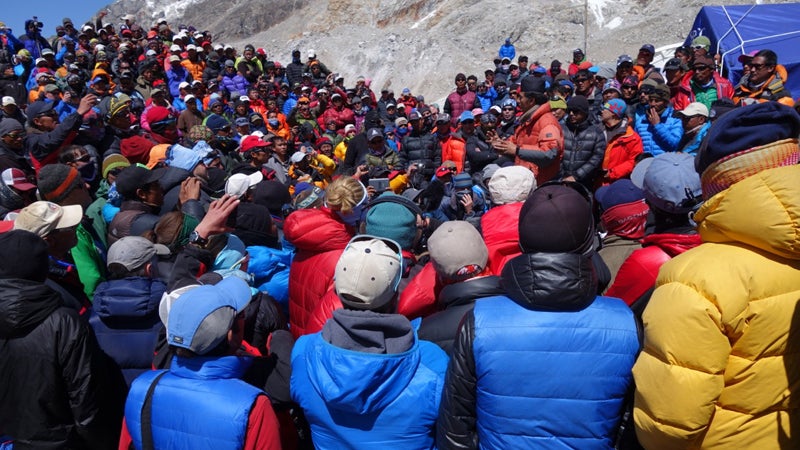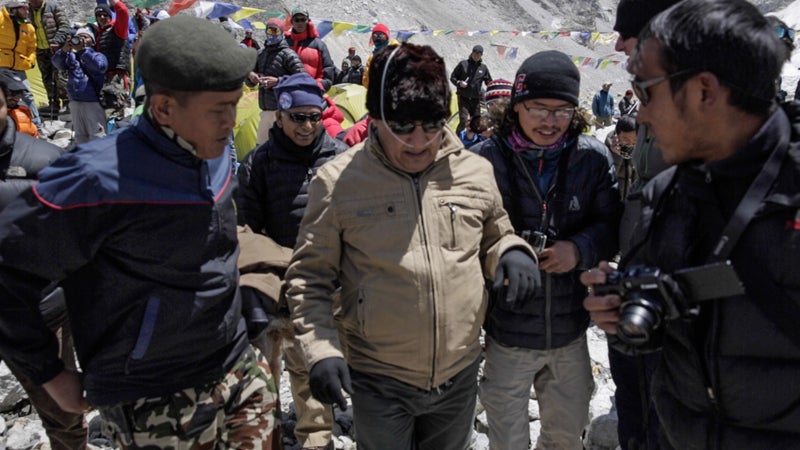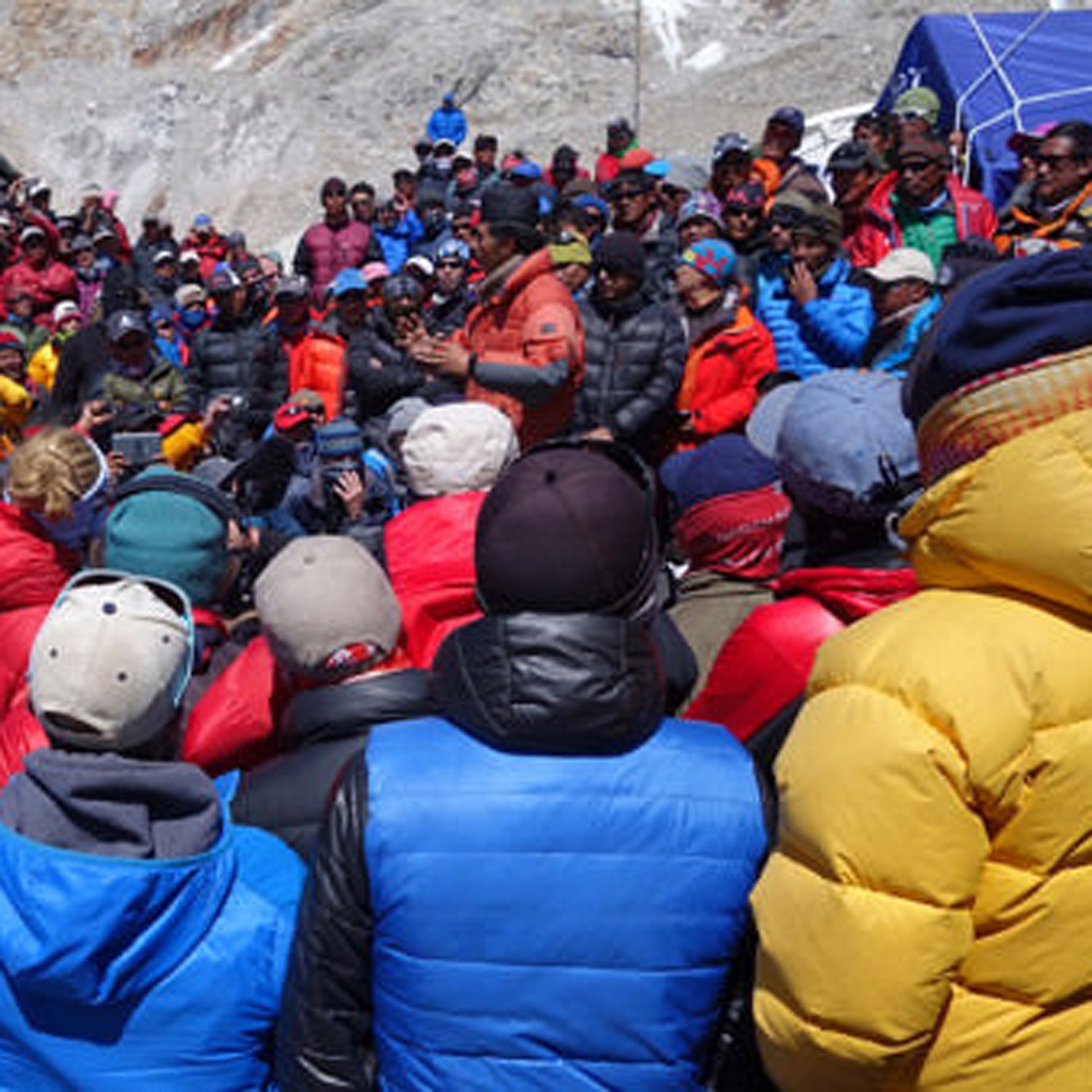Everest Base Camp looked cinematic and miniature racing by beneath the helicopter. Yesterday, I flew into the tent city at 17,600 feet as Nepal’s minister of tourism, Bhim Acharya—draped with a nasal cannula connected to an oxygen tank—was addressing a crowd of about 200 Sherpas bunched around the (SPCC) camp, home of the Icefall Doctors who are responsible for fixing the route through the Khumbu Icefall.
WATCH:
Watch VideoSeen from the above, the gathering had a theatrical quality to it. Several film crews thrust microphone booms toward Acharya, not so much because they needed to record what he said but because they wanted to capture the crowd’s reception of his words.

This was the government’s response to the unrest that’s followed the deadly avalanche on April 18. Over the weekend Nepal’s issued a 13-point charter demanding concessions like better insurance and disability coverage from the government and specifically indicated that they were not preventing any expeditions from continuing to climb the mountain. But reports of what exactly the Sherpas want, why, and whether any teams will continue to climb have been inconsistent.
I wanted to visit camp, if briefly, to try and sort through the conflicting statements in the media and by the players themselves. What seems to be happening is that, in public, both the government and the Sherpas are saying the climbing season should continue. In private, a smaller group of Sherpas has been forcefully coercing their coworkers to keep all expeditions off the mountain.
After the pilot landed at one of the camp’s three helipads, I approached the gathering as shouting broke out. It was hard to say whether the Sherpas were heckling the minister or cheering his promise to honor this year’s climbing permits for up to five years. Rainier Mountaineering’s Dave Hahn, like a lot of western guides, was watching from the outer edge of the assembly.
“Be careful,” he said. “Some people who we have a lot of respect for are pretty upset.” It was the first sign that things in camp weren’t what they seemed.
After Acharya finished speaking, the crowd parted, and two police officers helped helped him walk back to the helipad. Moments later, the hanging glacier on Everest’s West Shoulder released a large avalanche.
The previous night, local and western guides certified by the (IFMGA), along with other veteran Everest guides, met at the SPCC camp, home to the Icefall Doctors. They wanted to see whether everybody was in agreement about the dangers of the mountain and what to do going forward.
“As we went around the circle expressing our safety concerns,” Alpenglow Expeditions owner Adrian Ballinger, who was at the meeting, texted me, “much less was said about the Icefall dangers and much more was about Sherpa.”
Guides were not only afraid for the Sherpas but of them, a mood that recalled the incident last spring at Camp II, when several Sherpas roughed up European climbers Simone Moro and Ueli Steck. “I don’t think I can keep my members safe from Sherpa,” a veteran guide told the group. “I never thought I’d say that.”
LATER THAT NIGHT, more expeditions announced that they’d be leaving the mountain. In an email notifying clients that its 2014 expedition was officially over, Alpenglow’s team doctor Monica Piris explained: “There is an organised group of renegade Sherpa (small, but powerful and not from our team) who are threatening to act with direct violence towards anyone who chooses to stay.”
Several outfitters, along with enough Sherpas to support their climbs, did want to stay, among them Himalayan Experience, Altitude Junkies, International Mountain Guides, Alpenglow, Asian Trekking, and Arnold Coster Expeditions. But as the movement to stay heated up, so did the pressures to leave.
On his blog, Canadian Tim Rippel, owner of Peak Freaks, , “There is talk of retaliation on Sherpas who want to continue, and I’m not about to be part of this or put any of my staff or clients in danger.”
Thursday, U.K.–based outfitter of the saga and the rumored threats against anyone who wanted to stay and climb. “Our initial reaction wasn’t quite ‘bring it on’ but we certainly weren’t going to stop,” he wrote.
“Nobody knows who they are,” Garrett Madison of Madison Mountaineering told me of the provocateurs. Nobody is even sure whether the threats are real or simply loose talk by grieving friends who just want to go home.
According to Madison and several other guides in camp, those most outspoken against the government have included Kathmandu-based Himalayan Ascent’s Sumit Joshi, who is Nepalese but not Sherpa, and who lives in Australia. And there’s a Sherpa named Pasang Bhote who read aloud the Sherpas’ 13-point list of demands in Base Camp. The author of at least two of those points was Seven Summits director Tashi Sherpa. I asked him about the Sherpa-enforced climbing moratorium.
“I don’t know about that, man,” he told me. “That is a personal decision if you want to climb up. But the route is not fixed.”

Like most Sherpas in camp, he viewed the ministry visit as a success, a show of respect if nothing else. After all, the minister had only made it a little easier for clients to leave, knowing that their $10,000 per person permit fees might not be a total loss. He hadn’t promised to yield to any of the demands—only to bring them to the cabinet for consideration.
The last thing either the government or the Sherpas want to do is jeopardize Nepal’s lucrative Everest climbing industry. “We have to think about international investment,” said Tashi.
The implication is that if well-heeled clients begin to view Nepal’s labor politics as too volatile, they may return to Everest’s Tibetan side, which saw more traffic before Beijing shut down the mountain in 2008 for its Olympic torch relay team. But working with the Chinese government presents a different set of bureaucratic and political problems, not the least of which are a hefty fee on using imported labor and current strained relations with the United States.
YESTERDAY MORNING, FOLLOWING the summit in Base Camp, reports of what actually happened varied widely, a reflection of the complicated politics at play. Everest blogger Alan Arnette reported that the mountain was officially closed before hedging to The front page of the Kathmandu Post carried a story headlined “Spring Ascent Now at the Mercy of [Western] Climbers,” in which the Icefall Doctors are said to supposedly be ready to fix the route “even if there is only one climber.”
My read on the situation is that a smaller group of Sherpas viewed the April 18 avalanche as a tragedy but also a rare opportunity to lobby the government without being easily ignored. (Why they think the dysfunctional Nepalese government is better equipped to improve their working conditions than their outfitters is a mystery, but several guides have told me they think it’s about respect.) As an expedition logistics agent in Kathmandu told me: “They’re blackmailing in front of western clients. Their demands are reasonable, but this is not the way to do it.”
Meanwhile, nobody wants to be seen as the group responsible for shutting down Everest. In Lukla on Thursday, as he was waiting for his helicopter to Base Camp, Maddhu Sudan Burlakoti, Nepal’s joint secretary of the ministry of cultural tourism and civil aviation, told me the Sherpas “are ready to climb… They are going to climb.”
What comes next is seeing whether any team actually crosses the picket line. One that seems likely to try is Arnold Costur Expeditions. Over cinnabuns and espresso in his mess tent, Coster explained his position.
“They don’t want their brothers to go up and climb there,” he said. “I can understand that very well. But also they’re here to make money. A lot of sherpas still want to climb.” Coster, whose wife is Sherpa, says his plan is to “just wait, then go climbing.”
That might be more difficult after today. The 10,000 meters of rope, stored at ���ϳԹ��� Consultants’ camp for use in fixing the route to the summit, has been sent from Base Camp down to Gorak Shep to be put into storage. Keeping it in camp could have been viewed as a provocation.
Coster is apparently undeterred. Writing on his blog late Thursday, he said: “Our team is ready to climb and none of our Sherpas or members want to quit. Only a decision from the ministry level can stop us!”
That may not be the only thing.


